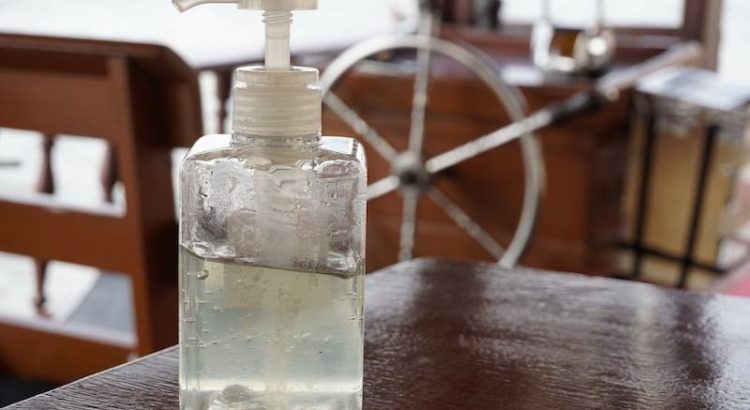This page contains affiliate links. This means that we may get a small commission for recommending products, if you choose to click on something and buy it. This does not cost you anything, but we wanted to be honest and let you know!
(Last Updated On: )If you consider yourself a boater you know how important personal hygiene is while onboard.
What you are about to read is not brand new information. Whether you spend hours or weeks on your boat, alone or with your friends, fishing or just sunbathing, there are certain on-boat hygiene basic rules to consider.
This might come again into attention especially these days.
Table of Contents
Self Quarantine on a Boat?
The entire world has been impacted by the COVID 19 virus since the beginning of 2020.
On March 13th, 2020, the headlines for CNN, an American based online newspaper read: “America On Hold.”
Still, you might think the best place to be at this point in time is on a boat in the middle of a lake or on the open sea.
It is the favorite place for many of us, but probably not the “self-quarantine” some boaters are talking about and should be taken a lot more seriously.
Personal Hygiene is Important

We have heard from many different sources that the best way to fight this virus and curtail the spread is through good personal hygiene.
While we are in the middle of facing the crisis that the World Health Organization is calling a pandemic, we have to remember that we have been through a crisis of this kind before, a few times in history.
We just want to say this situation brings back to our attention the simple fact that the basic rules of personal hygiene apply to our general health and wellbeing.
As always, one of the best defenses against illness is good personal hygiene. This, too, shall pass, and when we are on the other side of it, it would be smart to continue those hygiene practices.
Again, as the water is one of our favorite places to be, no matter what is going on, we thought it would be a good idea to remind you what hygiene products to take on board with us and what are some basic rules to follow at any time.
Basic Personal Hygiene Products to Take on Board
- Wet wipes: You can get a container or individually wrapped wipes. To minimize passing germs in the small area of a boat, get antibacterial wipes that can be used on your hands or surfaces on the boat
- Concentrated biodegradable soap: Being concentrated, you will need only a few drops. This soap will work as both a shampoo and a body wash.
- Toothpaste: Those kinds of toothpaste that contain oils such as eucalyptol, menthol, and tea tree can help kill bacteria in your mouth
- Deodorant: Deodorants (not antiperspirants) contain some antibacterial formula. There are those who swear by vinegar. Put some in a spray bottle and spritz it on.
- Sunscreen: You might not think of sunscreen as personal hygiene, but it will keep your skin healthier. Healthier skin is a healthier you.
- Low Sudsing Detergent: Clothes are like your second skin, so it is important to keep them clean.
- Clothes Line: Yes, another way to promote personal hygiene, hang your clothes out in the sun, as the ultraviolet rays of the sun bleach and disinfect your clothes.
- Kleenex: If you sneeze or cough, use a kleenex. If you do not have one available, sneeze into the crook of your elbow or upper arm.
- Antibacterial soap: Use this for washing our hands after using the restroom.
- Hand Sanitizer: It is easy to carry a pocket-size bottle of hand sanitizer. Use it whenever you have doubts about the surfaces you have touched.
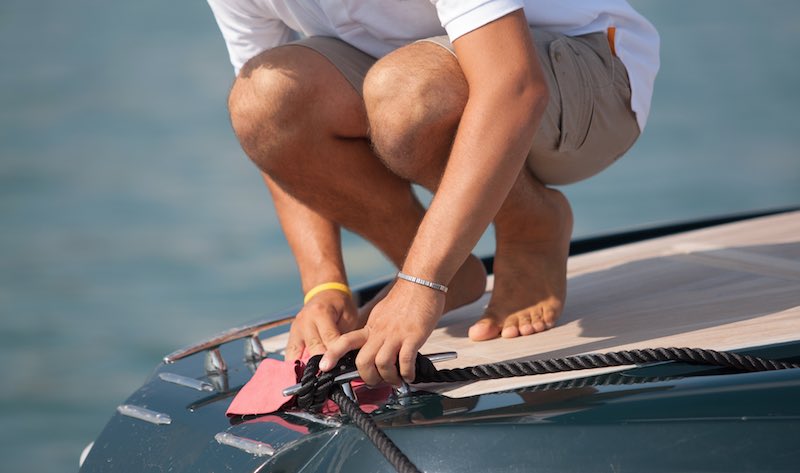
Establish a Routine
If you are going to be offshore for an extended period of time, establish a routine for your hygiene needs.
It is better to keep up with daily maintenance needs, like brushing your teeth, then to let it go and have problems develop.
Put together a personal hygiene kit that you keep on the boat at all times, and you will never be without the essentials.
How to Manage Personal Hygiene for an Extended Time
As we said before, don’t skip days when it comes to personal hygiene. Skipping days allows bacteria to grow and multiply.
There is an old saying, “An ounce of prevention is worth a pound of cure.” This is the absolute truth.
You could have all of the personal hygiene products that money can buy, but if you do not use them on a regular basis, it is all for naught.
There are easy ways to keep yourself clean with a minimum of expense or fuss. We have friends who stay out on their boat for a week or more at a time.
They have a unique way of showering that works well and is cheap and easy. They use a “milk bottle” shower.
They took a two-liter milk container that was empty and had been cleaned out.
They poked numerous holes in the lid of the container so that it looked much like a watering can.
They found that one full bottle of fresh water was all that was needed for a shower, two if you were also washing and rinsing out your hair.
There is no secret or any elaborate or particular protocol. Use the tips we outlined earlier and do them on a regular basis.
Wash Your Hands! Often!
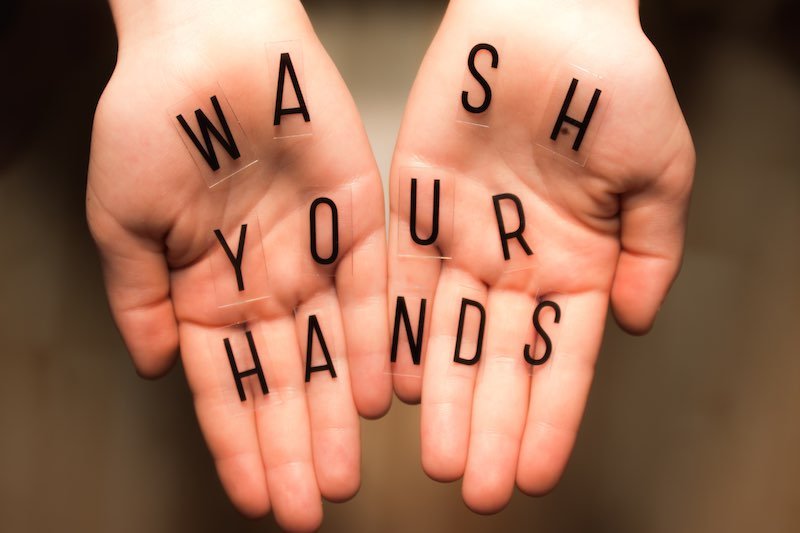
We have heard throughout our lives, and especially with the COVID 19 virus outbreak that you should wash your hands often throughout the day.
One of the reasons why we should do so is that we don’t realize how often we touch our faces.
On average, a person touches their face anywhere from 5 to 18 times every hour that they are awake.
That leaves a person open to transferring infection from their hands to their mouth, nose, or eyes.
So even while we are on the water, we should maintain boater personal hygiene.
The CDC tells us of the importance of this single act: Show Me the Science – Why Wash Your Hands? | Handwashing
When on a boat, you may have limited access to fresh water.
If the boat does not have a sink with running fresh water, make sure that you have brought along bottled water that is designated for handwashing.
Boat hygiene might sometimes be forgotten as we are around so much water, but it is still important to wash your hands.
When your hands need washing, you can pour a small amount into the palms of your hands and add biodegradable soap.
Rub that round and then a quick rinse from the water bottle, and you will be set.
Make sure that you use soap as fats and proteins don’t dissolve in water alone.
The most convenient way to keep germs off your hands is to use an alcohol-based hand sanitizer.
Squeeze a dime-size portion of sanitizer into your palm and rub your hands together to get all the surfaces.
In about 20 – 30 seconds, the alcohol will evaporate off of your hands.
Here is more from the CDC on how to wash your hands: When and How to Wash Your Hands | Handwashing
Don’t Forget Your Nails
Keeping your fingernails on the short side goes a long way to keep them clean.
Bacteria that cause vomiting and diarrhea can often be found under fingernails.
Handling raw fish meat, changing diapers, and not properly washing your hands after visiting the bathroom can be to blame.
Using an inexpensive nail brush will dislodge dirt and debris that isn’t reached during regular hand washing.
Check out the Mayo Clinics’ healthy nail-care tips to keep your nails healthy.
Which Brings Us to the “Facilities”

If you are so fortunate to have marine toilet facilities on your boat, you will already know what to do when Mother Nature calls.
Here are some tips for using your “head” correctly:
- Use biodegradable toilet paper only
- Use the head in moderation and only flush when needed
- NEVER put untreated sewage overboard. Protect the environment because it is the right thing to do, but also be aware that there are fines associated with illegal discharges
- Use one part bleach to ten parts of water when cleaning the head area to kill bacteria
- Locate local pump-out facilities
If you do not have toilet facilities aboard, you will have to improvise.
There are those, along with the American Chemical Society, that feel it is okay to pee in the ocean.
Use your judgment if it okay to urinate in the ocean, but small bodies of water and lakes may be a different story according to this article from TIME Magazine.
Another reason not to pee over the side of the boat has much more severe implications.
There are many boaters who have described situations in which they were answering the call of nature when the movement of the boat or a rogue wave has tossed them overboard.
If you are out by yourself, it can be a potentially life-threatening situation. Remember to use caution and be careful.
So what do you do? You can’t head to shore each time you need to use the facilities. So take your “facilities” with you.
You can purchase a marine porta potty for between one and two hundred dollars.
The potty can go wherever you go (or need to), and it will offer you everything but privacy.
If it is just you and a buddy or two, you could also do what this boater did: How to pee off your boat without falling overboard.
Food Safety on Board

It might not seem like personal hygiene, but keeping the food you bring on board safe does involve preventing bacteria from forming on the food you will ingest.
There are food safety practices that hold true a hundred years ago, just as they do today. Keep hot foods hot and cold foods cold.
There is a danger zone for food that becomes even more significant on a boat. The direct sunlight experienced on deck can be challenging to avoid.
Bacteria multiply rapidly in warm temperatures, and food can become unsafe after just two hours.
If the temperature is above 90 degrees, one hour is the maximum time limit.
On a boat, it is imperative to keep the food out of direct sunlight where the bacteria can grow and spoil food in even less than an hour.
If you are bringing food out on the water, you will need a cooler for perishable food.
Keep the cooler closed when you are not getting items out, and try to store it where it is not in direct sunlight.
It is not a bad idea to have two coolers, one for items like beverages that you will be using more often, and one cooler for perishable whose lid will not be lifted as often.
There are reflective “blankets” that can be draped over coolers that help keep the cooler protected from the sun’s rays.
Pack the cooler with several inches of ice, blocks of ice, or the frozen gel-packs that are available at most discount stores.
A block of ice will last longer than ice cubes. You could make your own by filling empty milk jugs that have been rinsed out.
If you use ice or ice blocks, store your food in a watertight container so that it will not get saturated from the melting ice.
Take small quantities with you. Don’t bring the entire jar of mayonnaise, just the amount you will use on your outing.
If the ice is melted in the cooler, or if the items are no longer cold, discard them once you reach the shore.
Again, Good Hygiene is Important
Keep everything that you bring with you clean. Wash your hands or use hand sanitizer before and after handling the food you have brought.
Keep the containers of food and their contents separate from each other. Don’t put the meat in with the chicken to avoid cross-contamination.
If you are not going to be consuming the food before it hits the danger zone, or if you do not have a cooler, consider other choices in foods to bring on the boat.
Fruits and nuts, vegetables, trail mixes, and peanut butter will do fine without refrigeration. Crackers and protein bars are easy to carry along and come in many varieties.
Dehydrated meats and jerky are ideal and will not need to be kept cold.
Safety While Fishing
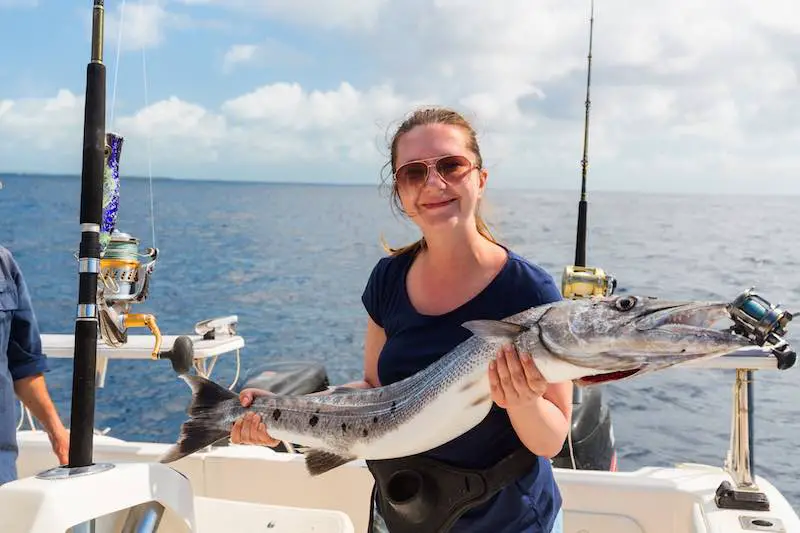
If your time out on the boat will also include fishing, there are guidelines for keeping your catch safe to consume, a sort of fishing hygiene.
Finfish:
- Keep live fish on stringers or in a live well so that they have enough water and room to move and breathe
- If not being kept alive, scale, gut and clean the fish as soon as they are caught
- Once cleaned, wrap the fish in watertight plastic and store on ice
- With 3 or 4 inches of ice on the bottom of the cooler, alternate layers of fish and ice
- Keep the cooler out of the sun
- Eat the fish within one or two days or freeze them
Shellfish
- Shellfish (crabs, lobsters, and all other shellfish) has to be kept alive until cooked
- Store the catch in live wells or store them in the water in a cage that is held under the water
- Eat crabs and lobster the day they are caught
- Mussels and clams need to be cooked within four to five days
- Oysters need to be prepared within seven to ten days
- It is NOT advisable to eat raw shellfish
Cooking Seafood Properly

Just as you needed to store seafood properly, so too, it needs to be cooked properly to avoid foodborne illness.
Seafood should be cooked to an internal temperature of 145 degrees. If you don’t have a food thermometer, get one.
They are relatively inexpensive, as little as $10, and are even more of a bargain if they save you from being sick.
The flesh on cooked fish should be clear and should separate easily with a fork.
The flesh on scallops, crab, lobster, and shrimp becomes firm and clear when it is thoroughly cooked.
Lobster and crabs will turn a bright red with a pearly-opaque flesh.
When cooking clams, oysters, and mussels, watch to make sure the shells open.
If there are some that do not open, throw those out as they will make you sick if they are eaten.
The best way to cook seafood is “low and slow.” That way, it does not dry out during cooking.
This list from the FDA will have a full guide to seafood safety.
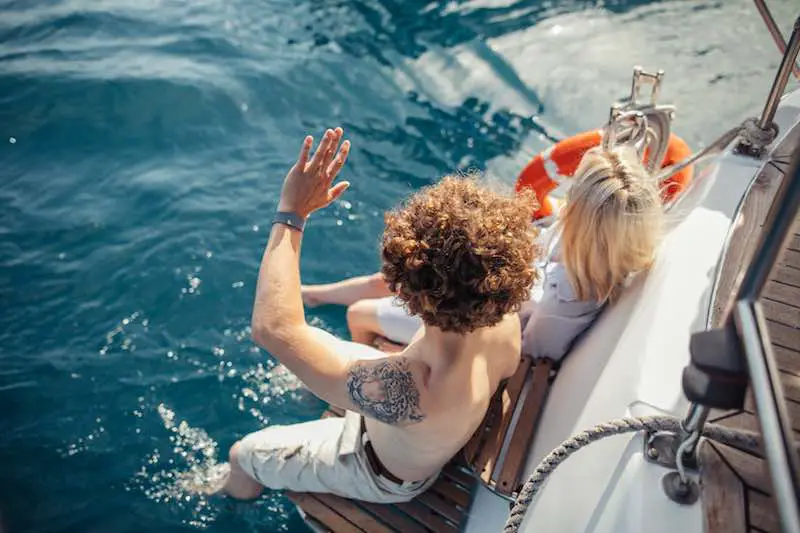
In Conclusion
We live in an ever-smaller world. We are a more mobile society than our parents or grandparents ever were.
We love traveling and getting out there in this big, beautiful world. It only makes sense to protect ourselves from illness and disease as much as is humanly possible.
Not just for ourselves, but also for our loved ones and those we come in contact with on a daily basis.
The current pandemic has brought home just how closely intertwined our lives are and that there is not any one of the personal hygiene practices that are difficult or cost a fortune.
All of them are common sense ways of keeping clean that we should employ each day. It can literraly save our lives.
These personal hygiene practices just take a bit of our time and an awareness of the importance of maintaining a daily hygiene regime.
